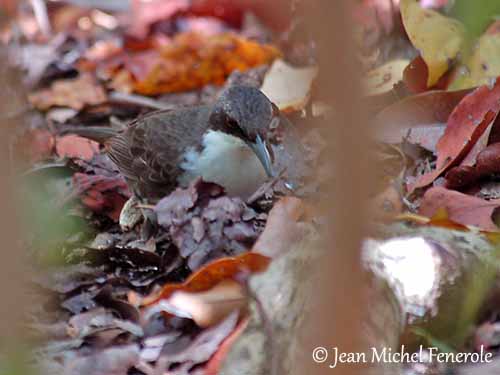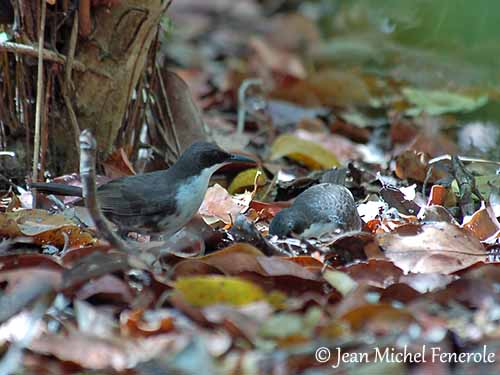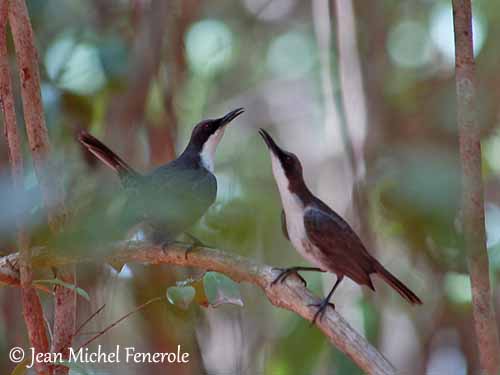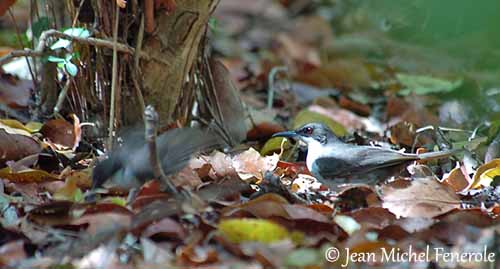
Fr: Moqueur gorge-blanche
All: Weißbrust-Spottdrossel
Esp: Cuitlacoche Pechiblanco
Ita: Mimo codacorta
Nd: Witborstspotlijster
Sd: Vitbröstad härmtrast
Photographer:
Jean Michel Fenerole
Photos d’Oiseaux du monde
Text by Nicole Bouglouan
Sources :
HANDBOOK OF THE BIRDS OF THE WORLD Vol 10 by Josep del Hoyo-Andrew Elliott-David Christie - Lynx Edicions - ISBN: 8487334725
WRENS, DIPPERS AND THRASHERS by Brewer David – illustrated by Barry Kent Mackay- Yale University Press - ISBN: 0300090595
BirdLife International (BirdLife International)
Birds & Co – Les Oiseaux de Martinique
Neotropical Birds – Cornell Lab of Ornithology
White-breasted Thrasher
Ramphocinclus brachyurus
Passeriformes Order – Mimidae Family
INTRODUCTION:
The White-breasted Thrasher is a critically endangered species with restricted range in the Lesser Antilles. It is confined only to two islands. Its decline is primarily due to habitat loss and tourism development.
DESCRIPTION OF THE BIRD:
Biometrics:
Length: 20-23 cm
Weight: R.b. brachyurus: 48 g – R.b. sanctaeluciae: 60 g
The adult of nominate race has dark brown upperparts with greyish-white edging on scapulars. Lower back and rump are slightly more rufescent. Flight feathers and rectrices are brownish-black.
The underparts are white except the brown vent and the blackish-brown flanks.
On the dark brown head, we can see a faint white supercilium. Lores to ear-coverts are blackish. There is sometimes a faint white scaled effect on the head.
The bill is slightly decurved and relatively long. It is black with brown base to lower mandible. The eyes are red to reddish-brown. Legs and feet are dark grey.
Both sexes have similar plumage, but the female is slightly smaller than male and she has shorter bill too.
The juvenile is brown overall. It develops a creamy-white patch on the breast with age.
SUBSPECIES AND RANGE:
There are two subspecies.
R.b. brachyurus (here described and displayed) occurs on Martinique, in C Lesser Antilles.
R.b. sanctaeluciae is found on St Lucia, in SC Lesser Antilles. This one is darker and larger than nominate.

HABITAT:
The White-breasted Thrasher frequents dry and semi-dry woodland and scrub, and dense coastal thickets with no ground cover but with abundant leaf-litter.
On St Lucia, the species may occur along ravines and river-valleys, and on both islands, it can be found on the dry hillsides, away from streams. It is absent from the true rainforest.
CALLS AND SONGS: SOUNDS BY XENO-CANTO
The White-breasted Thrasher gives short, harsh calls “chek-chek-chek-chek” on Martinique. The alarm call is a harsh “tschhhh” on St Lucia, and “grok-grok” on Martinique. It may occasionally utter a musical “tee-rou”.
The song is a series of repeated short, varied phrases “te-ru-ti, ti-a-ritu…”
The juvenile gives thin “tseep” calls when it is on the ground.

BEHAVIOUR IN THE WILD:
The White-breasted Thrasher feeds on terrestrial arthropods, small vertebrates such as lizards and frogs, fruits and berries.
It forages on the ground among the leaf-litter. It sweeps the dead leaves aside with bill and legs, in order to catch invertebrates and small vertebrates. It may climb into the vegetation over several metres. It plucks fruits and berries from trees, performing a clumsy fluttering flight. It is more adapted to terrestrial foraging than arboreal behaviour.
When the bird is excited or agitated, it drops its wings like numerous Mimidae, but it does not vibrate them. Head and neck are stretched and the tail is slightly cocked while the wings are drooped. The bill is open and the bird utters a constant warning chatter. The White-breasted Thrasher is territorial all year round. It defends the territory by singing and by performing some displays such as “wing-lifting” and some others used in courtship too.

This species is sedentary in its range, and does not perform long-distance flights.
REPRODUCTION OF THIS SPECIES:
The breeding season occurs between April and August, at the onset of the rainy season.
Co-operative breeding has been reported recently on both islands, with one pair and additional helpers, mainly retained offspring.
The nest is a bulky open cup, placed in shrub or in the fork of a thin sapling, at about 2-8 metres high on Martinique, and 0, 50 and 3 metres on St Lucia. It is made with twigs and leaves, and the inner cup is lined with grass and rootlets.
The female lays 2 greenish-blue, unmarked eggs. The incubation lasts 14 days, and the chicks fledge about 12 days after hatching. They remain on the ground and depend on their parents for food.
This species can produce 2-3 broods per year.
The nest-predators are mongooses, opossums, rats, snakes and the Pearly-eyed Thrasher.
PROTECTION / THREATS / STATUS:
The White-breasted Thrasher is threatened by habitat loss and predation by introduced mammals.
Habitat destruction is due to expansion of agriculture, wood-cutting and human developments such as roads and housing.
The global population is estimated at least 1,300 mature birds, involving about 1,900 individuals in total.
This species occurs in restricted range too.
For these reasons, the White-breasted Thrasher is considered as critically Endangered.
